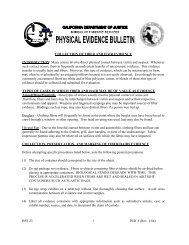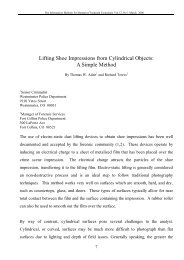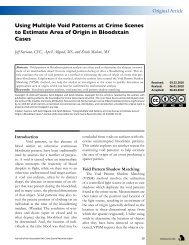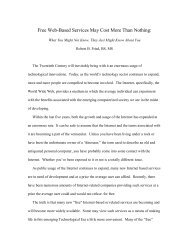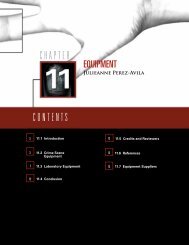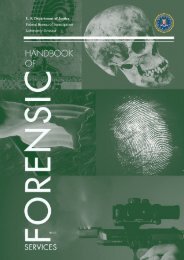PHYSICAL EVIDENCE MANUAL - Crime Scene Investigator Network
PHYSICAL EVIDENCE MANUAL - Crime Scene Investigator Network
PHYSICAL EVIDENCE MANUAL - Crime Scene Investigator Network
Create successful ePaper yourself
Turn your PDF publications into a flip-book with our unique Google optimized e-Paper software.
Physical Evidence Manual<br />
Adopted: May 2002<br />
Revisions: 6<br />
Last Revision: January 31, 2008<br />
7.0 CONTROLLED SUBSTANCES<br />
Controlled substance analysis is the identification of specific chemicals that are<br />
designated as controlled by the Oregon Administrative Rules. This analysis<br />
applies to the testing of powders, tablets, capsules, plant material, and drug<br />
paraphernalia. Clandestine laboratory samples are also analyzed to determine<br />
the method being used to manufacture the illegal drug and the possible drug<br />
yield given the quantity of chemicals and precursors seized.<br />
Analysis of Controlled Substances<br />
• Identification of controlled substances only. In general, non-controlled<br />
substances are not identified.<br />
• Analysis is qualitative only. Oregon law requires only the presence of a<br />
controlled substance, not its purity.<br />
• Quantitative testing is performed for federal sentencing in<br />
methamphetamine cases only.<br />
Submission Policies<br />
Each laboratory limits analysis to two items per defendant, so the investigating<br />
officer should use discretion and submit only those two items that are essential to<br />
the case. Exceptions can be made by District Attorney’s Office request to the<br />
laboratory. In cases with multiple suspects, an indication should be made as to<br />
what evidence belongs to which suspect.<br />
Large seizures of over a kilogram of powder or large amounts of marijuana<br />
should not be submitted directly to the laboratory. A small sample of the material<br />
should be removed, packaged, and submitted for analysis. Laboratory personnel<br />
can assist with the weighing of large submissions, however, the officer must<br />
maintain possession of the evidence. A small sample will be retained by the<br />
laboratory for analysis.<br />
Syringes, razors, and other sharp objects (“sharps”) will not be accepted unless<br />
the District Attorney’s Office has given notice of their intent to prosecute the<br />
case. All sharp objects should be separated from other evidence that requires<br />
analysis.<br />
Approved sharp objects that are submitted for analysis must be packaged in<br />
such a manner as to protect personnel during handling. The packaging must be<br />
protective enough to ensure no possibility of being injured or punctured.<br />
Commercially manufactured puncture-proof (“sharps”) containers are available<br />
for purchase. Contact your local laboratory for information.<br />
7-1



